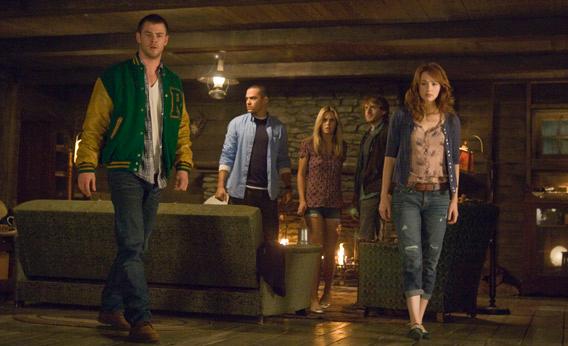Cabin in the Woods
Joss Whedon's movie has twisted fun with slasher movie clichés.

Still by Diyah Pera/Lionsgate.
After you've seen Cabin in the Woods, come back and listen to our Spoiler Special:
This may have to be a very short review, because Cabin in the Woods (Lionsgate) is a movie that starts with the plot twists within the first 10 minutes and keeps on twisting till it resembles a double helix. Though not every one of these reversals is brilliant, or even unpredictable, you have to admire the clip at which they keep on coming. This horror-inflected black comedy is a playful riff on the “last girl” slasher movie, in which a group of young people in isolation are hunted down one by one by a murderous, often supernatural entity who tends to save the pretty virgin for last.
Written by Buffy the Vampire Slayer creators Joss Whedon and Drew Goddard and directed by Goddard, Cabin in the Woods doesn’t spoof slasher clichés in the mode of, say, the Scream series, nor does it embrace them. Rather, Whedon and Goddard imagine a fantastical back story behind the clichés. In addition to being a comedy and a horror movie, Cabin in the Woods is a dystopian fantasy about a world in which the familiar slasher-movie tropes are all part of a vast … see, now I’m approaching spoiler territory already.
This much, at least, is safe to say: Cabin in the Woods accompanies five college students on a weekend trip, cutting back and forth between the titular isolated cabin and a high-tech control room from which a group of technicians seem to be remotely managing the travelers’ entire experience. Hadley (Bradley Whitford) and Sitterson (Richard Jenkins), dressed like a pair of mid-1960s NASA engineers, lead the control-room team, casually barking out orders that will decide the cabin-dwellers’ fate (“Release the pheromones!”) and running a hardhearted betting pool on which young person will die first. Meanwhile, their victims labor under the comically obvious misapprehension that they’re acting on their own free will.
The five chumps in the cabin include the naïve, studious Dana (Kristen Connolly), an apparent shoo-in for “last girl” status, and her roommate Jules (Anna Hutchison), who’s just gone blond as the movie begins, the better to embody the “punishable slut” stereotype. Traveling with them are three men: Jules’ boyfriend (Chris Hemsworth), a friend he’s trying to set up with Dana (Jesse Williams), and their weed-smoking sidekick (Fran Kranz, very funny as, in essence, a live-action version of Shaggy from Scooby-Doo.) With the possible exception of Kranz’s crazy-like-a-fox stoner, none of these kids seem like the brightest of bulbs: One of the movie’s chief sources of jokes is the equanimity with which the whole gang ignores glaring hints that something is amiss at their creepy vacation spot.
Really, these five are less characters than game pieces, both for the team in that mysterious control room and for the audience. They exist so that the script can move them, with varying degrees of cleverness and surprise, through a series of plot developments that borrow from, and pay affectionate tribute to, pop genres from schlock horror to Twilight Zone-style speculative sci-fi to higher-brow cult fare. (There’s a gallery of nightmarish creatures near the end that recalls Guillermo del Toro’s creations for Pan’s Labyrinth, but goofier.)
Perhaps because it cultivates this audience disengagement from the main characters’ fate—we’re rooting for our own entertainment, not their survival—Cabin in the Woods rarely comes across as more than a cleverly constructed meta-cinematic puzzle. It’s often funny and smart, but seldom deeply involving, and practically never scary. The last 10 minutes or so suffer from that problem not uncommon in high-concept movies, whereby the story paints itself into a conceptual corner and the forward motion flags. I also wish the film had ended a minute earlier, allowing the audience and the protagonists to persist in a state of ambiguity as to the ultimate meaning of … well, the undisclosable things that the story is about.
Though Cabin in the Woods struck me as a minor success, a pleasant trifle that ended just in time to avoid exhausting its central conceit, people around me in the theater were whooping it up like undergrads on spring break, and the conversations on the way out of the theater sounded buzzed and heady. I thoroughly enjoyed this movie’s gory silliness, but I have the feeling it may be overpraised for infusing a modicum of wit into a genre that usually demonstrates so little. If Goddard and Whedon’s smart-aleck goof is all it takes to change the slasher-movie game, that may just prove it’s a game that really needed changing.
